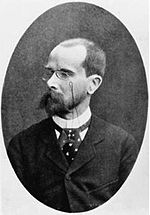Eugène-Anatole Demarçay
Eugène-Anatole Demarçay ( January 1, 1852 - March 5, 1903 Paris ) was a French chemist .
Life
Demarcay studied at the École Polytechnique and was there from 1874 assistant to Auguste André Thomas Cahours , where he received his doctorate in 1880. Later he did his research privately.
Demarçay was one of the discoverers of the element europium , which he first detected spectroscopically and isolated in 1901. During this time he helped Marie Curie with spectroscopic investigations to isolate the radium from pitchblende .
He was one of the first chemists to study the odorous substances in plants. He investigated gases under pressure at low temperatures and constructed a refrigeration machine based on the Joule-Thomson effect . With his teacher Cahours he studied esterification reactions and was one of the first to use acetoacetic esters for organic syntheses. From 1880 he dealt with spectroscopy and used it to separate rare earths, for which he developed a process with fuming nitric acid. This also led to his discovery of europium.
Fonts (selection)
- Eugène Demarçay: Specters électriques. Atlas . Gauthier-Villars, Paris 1895; OCLC 54317437 .
- Eugène Demarçay: Sur les acides tétrique et oxytétrique et leurs homologues . Gauthier-Villars, Paris 1880; OCLC 25644291 .
Technical article
- Sur le specter d'une substance radio-active. Comptes rendus, 127: 1218, 1898.
- Sur le specter du Radium. Comptes rendus, 129: 716-717, 1899.
- Sur le specter du radium. Comptes rendus, 131: 258-259, 1900.
literature
- Winfried R. Pötsch (lead), Annelore Fischer, Wolfgang Müller: Lexicon of important chemists , Harri Deutsch 1989, p. 113
Web links
- Literature by and about Eugène-Anatole Demarçay in the SUDOC catalog (Association of French University Libraries)
- Information on Eugène-Anatole Demarçay in the database of the Bibliothèque nationale de France .
| personal data | |
|---|---|
| SURNAME | Demarçay, Eugène-Anatole |
| BRIEF DESCRIPTION | French chemist |
| DATE OF BIRTH | January 1, 1852 |
| DATE OF DEATH | March 5, 1903 |
| Place of death | Paris |
